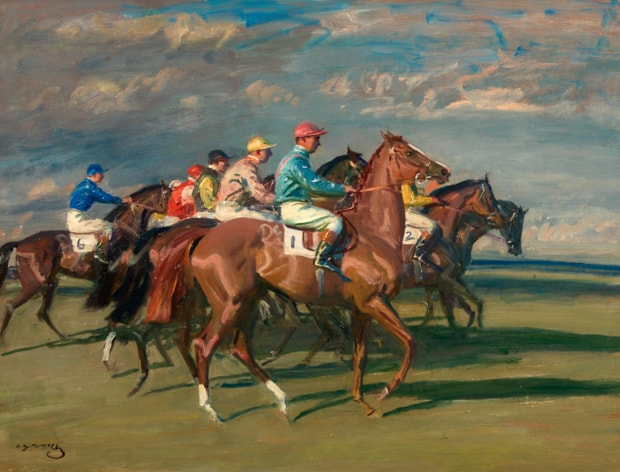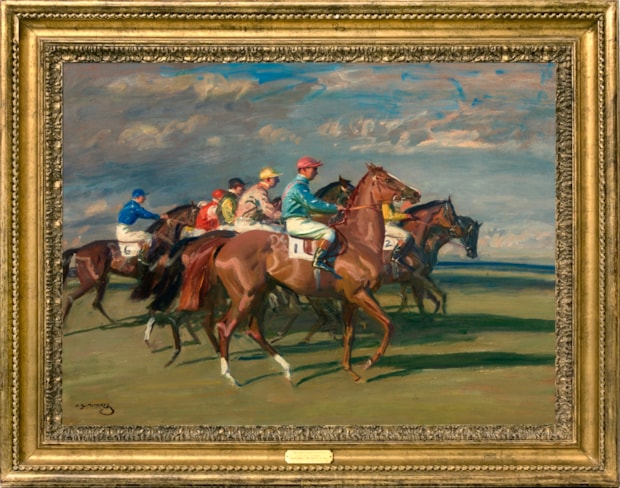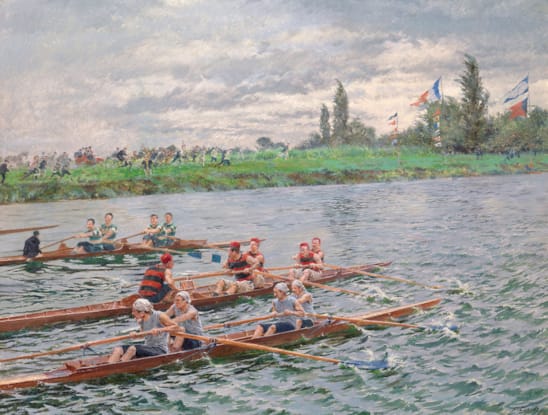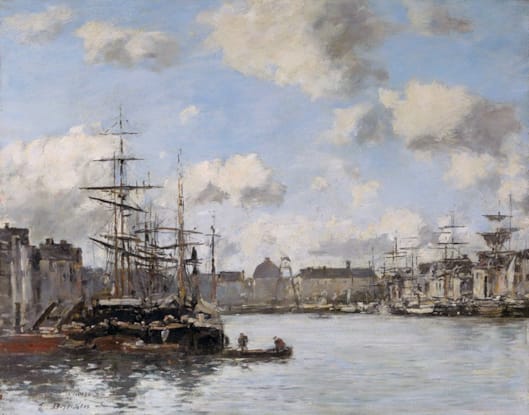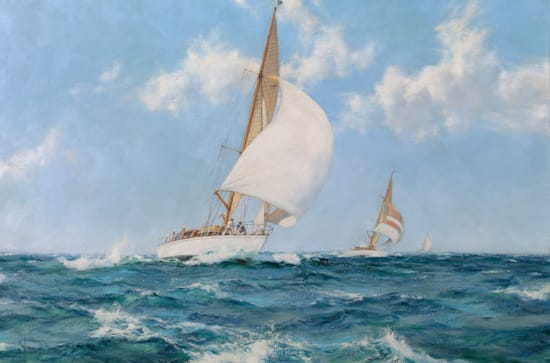Sir Alfred James Munnings, KCVO, PPRA
(1878 - 1959)
Lord Astor’s High Stakes with Sir Gordon Richards Up at Newmarket
Signed, lower left: A.J. MUNNINGS
Oil on panel
20½ x 27¼ in – 52 x 69.2 cm
Frame size
27¼ x 33¾ in – 69.2 x 85.7cm
Oil on panel
20½ x 27¼ in – 52 x 69.2 cm
Frame size
27¼ x 33¾ in – 69.2 x 85.7cm
Height 3¹/₄ in (69.2 cm)
width 9³/₄ in (85.7 cm)
width 9³/₄ in (85.7 cm)
Tel.: +44 (0)20 7839 7693
Provenance
Collection of the artist (1956);
Collection of Pamela Woolworth Combemale;
Sale, Christie’s, London, 13 November 1964, lot 40;
Frost & Reed, London, 1976;
Private collection, USA;
MacConnal-Mason Gallery, London, 1997;
Private collection, UK
Collection of Pamela Woolworth Combemale;
Sale, Christie’s, London, 13 November 1964, lot 40;
Frost & Reed, London, 1976;
Private collection, USA;
MacConnal-Mason Gallery, London, 1997;
Private collection, UK
A.J. Munnings, The Finish, Bungay, 1952, pp.304-5 (another version)
London, Royal Academy, Munnings Retrospective Exhibition, 1956, no.229
Munnings began his series of 'Start' paintings in the early 1940s and continued until his death. In virtually all of such compositions, Munnings excludes elements such as the race marshall, crowds or grandstands and focuses exclusively on the field of horses; by removing these distractions, the sense of tension and excitement, which exists prior to the start of a race, is increased markedly. The setting of Newmarket, with its broad, open heathland and big sky contrasts beautifully with the vivid jockeys' silks and provides a fitting backdrop to frame the scene. Munnings was even given permission by The Jockey Club to set up a studio at the course, in an old rubbing-down barn. The series represents another instance of the artist pioneering away from formal equestrian portraiture and instead painting racehorses very much in their element. He provides a telling recollection in his biography, 'I am standing on the course -- the most beautiful course in the world: cloudless October sky, a faint wind from the east....I am looking at the scene, the old, old scene -- a centuries old scene. Horses come up the course looking like those of years ago....Bright colours in the sun just the same as of yore....What a sight for the artist! with the long shadows and the lights on the boots, lights on the horses....This is the best picture I have ever seen.' (Sir Alfred Munnings, The Finish, London, 1952). The present work is undoubtedly one of the most important in the series as it shows a named jockey and horse, whereas in the majority of other 'Starts', the field is anonymous. High Stakes, by Lord Derby's 1933 Derby winner Hyperion out of 1929 Oaks winner Pennycomequick, was one of numerous racehorse commissions from Lord Astor. Sir Gordon Richards (1904-1986) is considered to be one of the greatest jockeys in the history of the turf with 4870 wins. He was British flat racing champion 26 times and, along with A.P McCoy, is the only jockey to receive a Knighthood. In 1926, his debut year, he rode to victory in 118 races. He missed the 1927 season having contracted tuberculosis but recovered the following year. 1932 saw him break the record for wins in a season with 259, a record he broke in 1947 with 269 wins. He won all of the classic races on numerous occasions, except the Derby which eluded him until 1953, when he finally rode Pinza to victory, overtaking the Queen's horse Aureole and the Aga Khan's Shikampur in the final two furlongs.
Biography
Sir Alfred J. Munnings was an artist of the twentieth century steeped in the traditions and values of the past. His artistic training was not dissimilar to that of a seventeenth century Master. Showing some early talent, Munnings was apprenticed to a firm of lithographers, Page Brothers in Norwich for six years, studying at Norwich School of Art in the evening.
He had some success locally and showed two paintings at the Royal Academy in 1899. In the same year he returned to set up his studio in Mendham, and in an accident lost the sight in one eye. In his early years he supplemented his income by designing posters at which, with is consummate draughtsmanship he excelled. He studied briefly in Paris between 1902 and 1903.
Munnings drew his subject matter from the East Anglian landscape and rural society. A horse fair of 1901 showed an early interest in horses while fairgrounds and rural occupations provided the artist with considerable subject matter. 1910 saw Munnings visit Lamorna in Cornwall where he met Laura (1877-1970) and Harold Knight (1874-1961), lifelong friends, and where he stayed between 1911 and 1916. In 1913 he held his first one-man show at the Leicester Galleries, where Laura Knight, DBE, RA showed.
In 1918 Munnings was appointed as a war artist with the Canadian Cavalry Brigade, producing an important body of work for the Canadian Government. Munnings settled in Dedham in 1918, marrying Violet in 1920. He was elected Royal Academician in 1925, to the RWS in 1929, in 1944 Munnings was knighted and elected President of the Royal Academy between 1944 and 1949. In this latter role he famously made known his utter contempt for ‘Modern Art’. Munnings was a prolific artist and a consummate draughtsman, whose work as a war artist raised his profile and reputation. Best known for his equestrian works, portraits and racing works, Munnings range was enormous. He excelled in landscape and scenes of rural life, recording a way of life that was coming to an end.
His works are in the collections of HM the Queen, J. Mitchell Chapman, Lord Fairhaven and Major Sir Reginald Macdonald Buchanan. His works can be found in museums in: Birmingham; Liverpool; London, Tate Gallery; Norwich; Preston; USA, Yale University; Brisbane and Melbourne.
He had some success locally and showed two paintings at the Royal Academy in 1899. In the same year he returned to set up his studio in Mendham, and in an accident lost the sight in one eye. In his early years he supplemented his income by designing posters at which, with is consummate draughtsmanship he excelled. He studied briefly in Paris between 1902 and 1903.
Munnings drew his subject matter from the East Anglian landscape and rural society. A horse fair of 1901 showed an early interest in horses while fairgrounds and rural occupations provided the artist with considerable subject matter. 1910 saw Munnings visit Lamorna in Cornwall where he met Laura (1877-1970) and Harold Knight (1874-1961), lifelong friends, and where he stayed between 1911 and 1916. In 1913 he held his first one-man show at the Leicester Galleries, where Laura Knight, DBE, RA showed.
In 1918 Munnings was appointed as a war artist with the Canadian Cavalry Brigade, producing an important body of work for the Canadian Government. Munnings settled in Dedham in 1918, marrying Violet in 1920. He was elected Royal Academician in 1925, to the RWS in 1929, in 1944 Munnings was knighted and elected President of the Royal Academy between 1944 and 1949. In this latter role he famously made known his utter contempt for ‘Modern Art’. Munnings was a prolific artist and a consummate draughtsman, whose work as a war artist raised his profile and reputation. Best known for his equestrian works, portraits and racing works, Munnings range was enormous. He excelled in landscape and scenes of rural life, recording a way of life that was coming to an end.
His works are in the collections of HM the Queen, J. Mitchell Chapman, Lord Fairhaven and Major Sir Reginald Macdonald Buchanan. His works can be found in museums in: Birmingham; Liverpool; London, Tate Gallery; Norwich; Preston; USA, Yale University; Brisbane and Melbourne.
